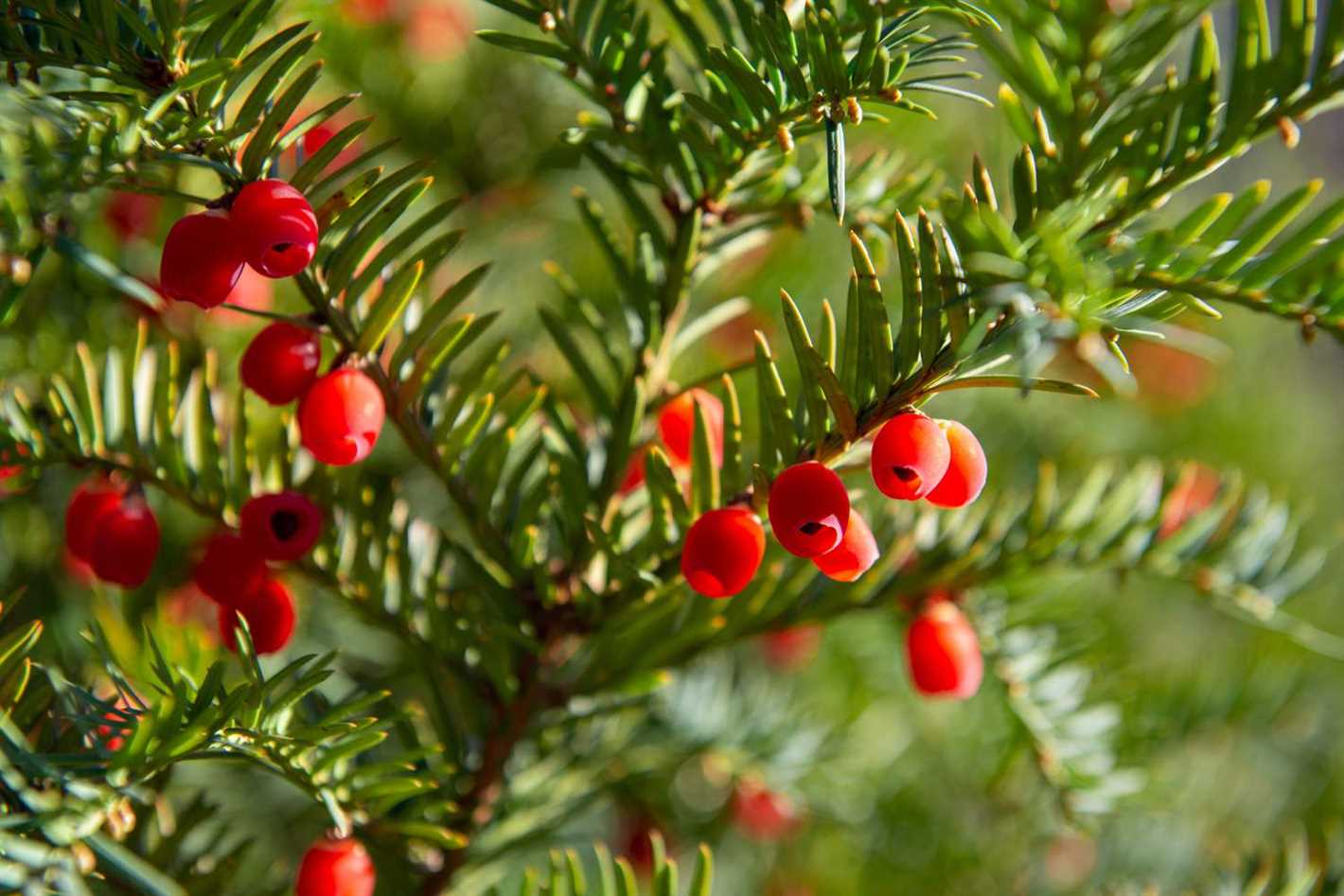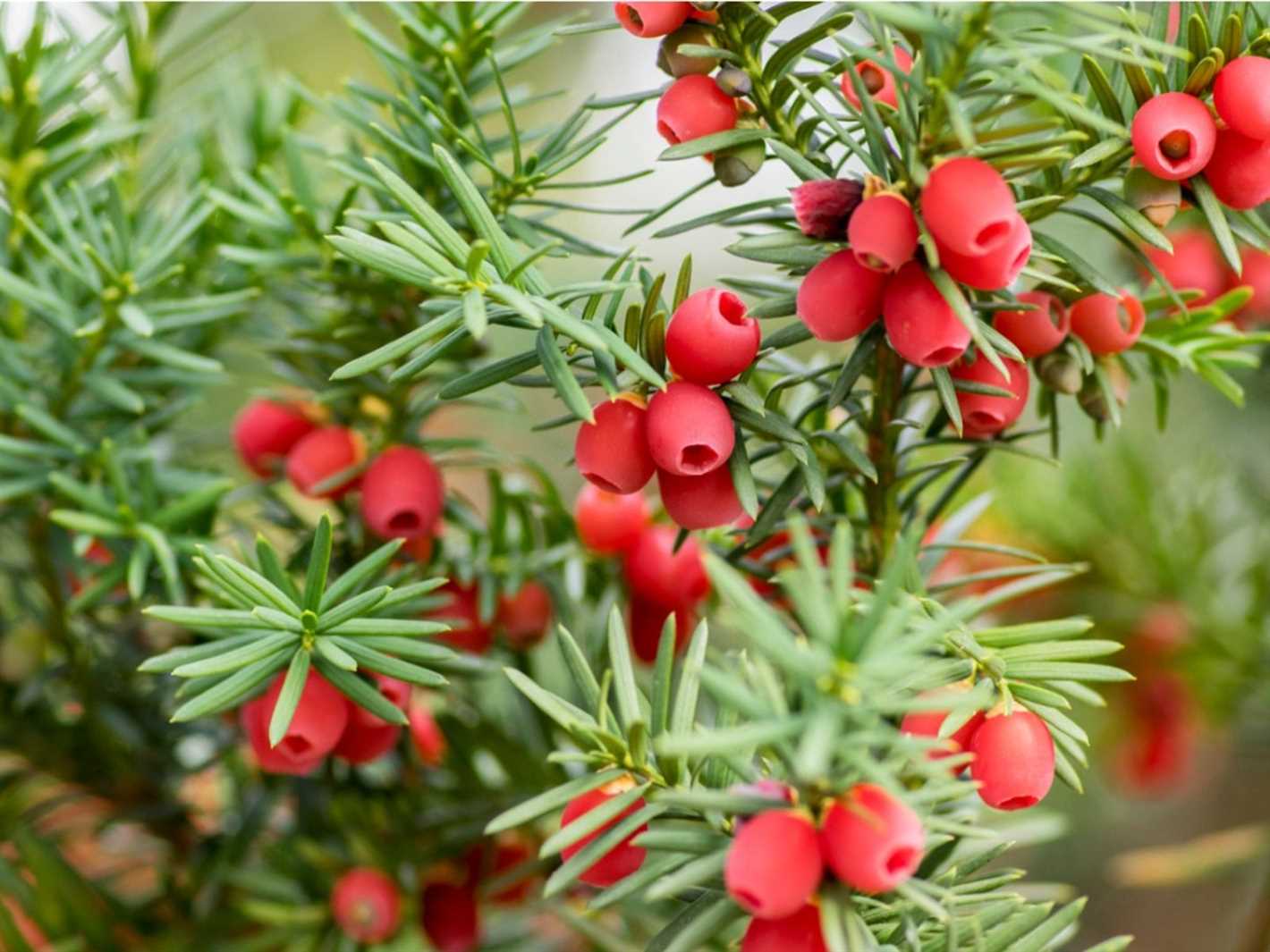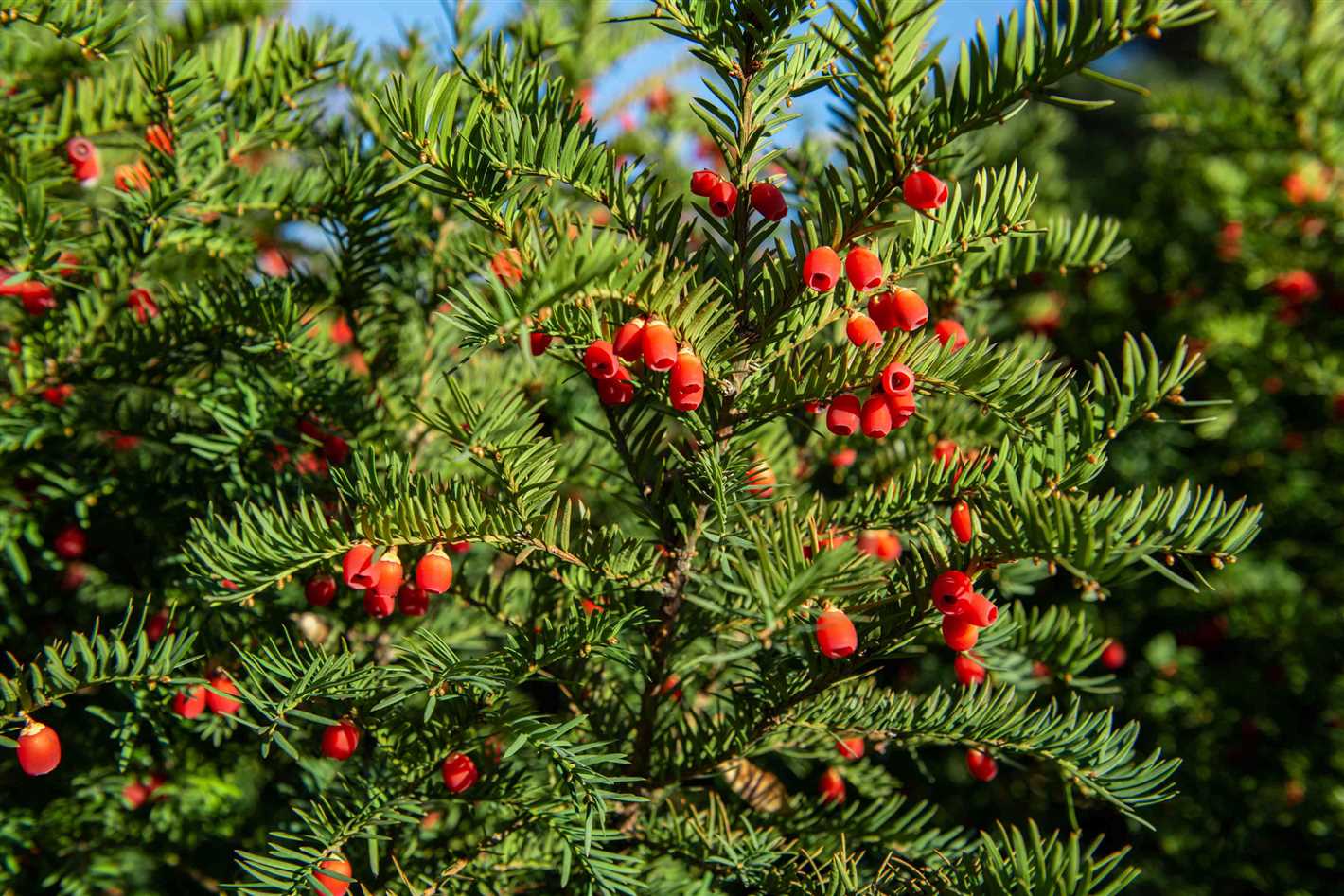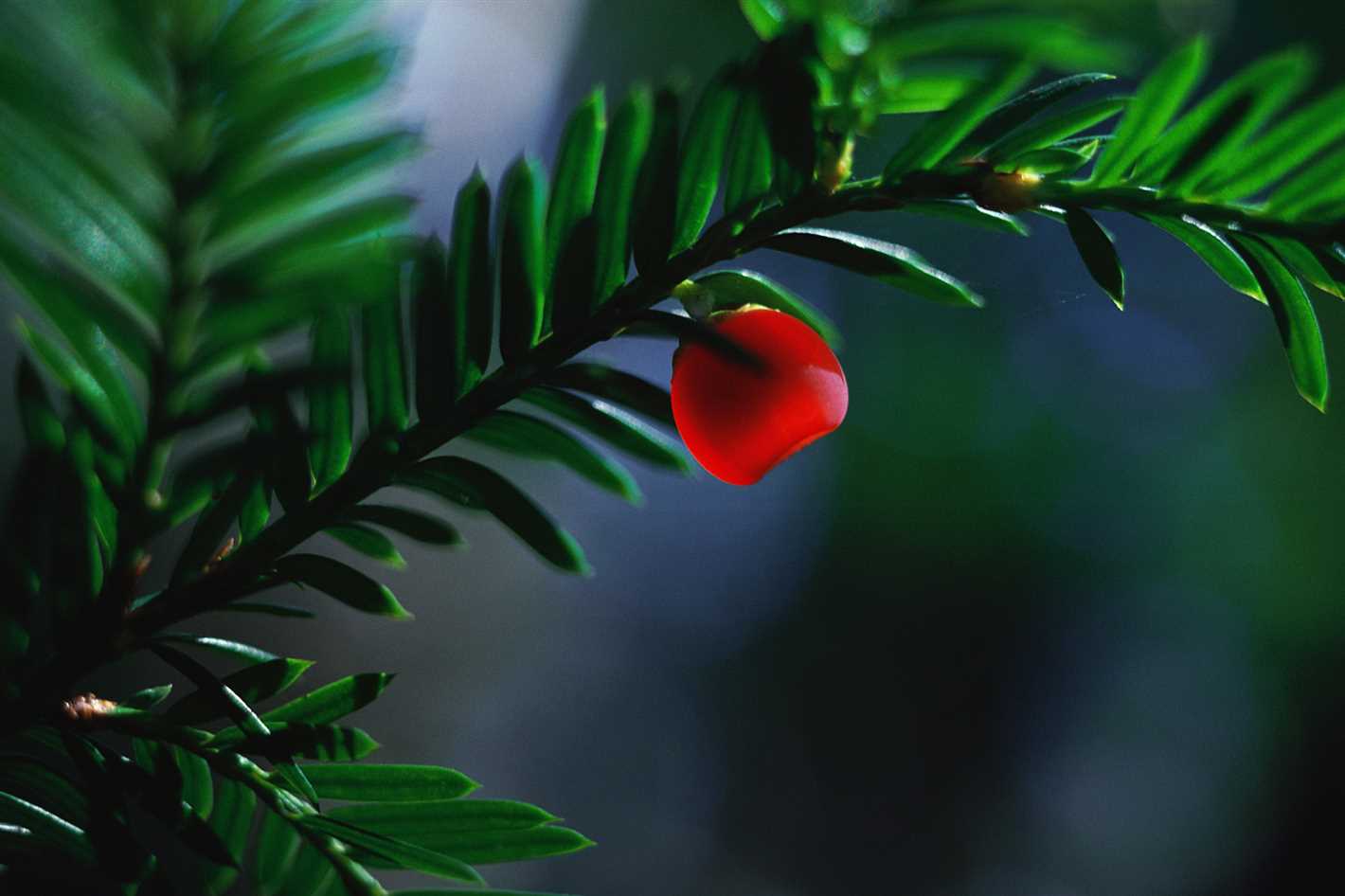- Choosing the Right Location: Sunlight and Soil Requirements
- Sunlight Requirements
- Soil Requirements
- Site Selection
- Summary
- Planting Techniques: Timing, Digging, and Preparing the Soil
- Timing
- Digging
- Preparing the Soil
- Propagation Methods: Seeds, Cuttings, and Grafting
- Seeds
- Cuttings
- Grafting
- Watering and Fertilizing: Tips for Proper Care
- Watering
- Fertilizing
- Pruning and Shaping: Maintaining a Desired Form
- Why Pruning is Important
- When to Prune
- Basic Pruning Techniques
- Tools for Pruning
- Maintenance Pruning
- Common Pests and Diseases: Prevention and Treatment
- Pests
- Diseases
- Harvesting and Using Berry Yew: Culinary and Medicinal Applications
- Harvesting Berry Yew Berries
- Culinary Uses of Berry Yew Berries
- Medicinal Applications of Berry Yew Berries
- Questions and Answers:
- What is a berry yew?
- How do I plant a berry yew?
- When is the best time to plant a berry yew?
- How often should I water a berry yew?
- How do I propagate a berry yew?
- What are the common pests and diseases that affect berry yew?
- Videos: Why Do Cuttings Fail? Propagation Tips
Growing berry yew can be a rewarding and satisfying experience for any gardener. This ornamental plant, known for its vibrant and colorful berries, adds a touch of beauty to any garden or landscape. Whether you’re a novice gardener or an experienced horticulturist, this complete guide to propagation will provide you with the necessary knowledge and tips to ensure successful planting and caring for berry yew.
Propagation Methods
There are several methods of propagating berry yew, each with its own advantages and considerations. One of the most common methods is through seed propagation, which involves collecting ripe berries, extracting the seeds, and planting them in a suitable growing medium. Another method is through stem cuttings, where healthy and mature stems are cut and rooted in a rooting hormone and then planted in a pot or prepared soil.
Choosing the Right Location
Berry yew thrives in well-drained soil and prefers partial shade to full sun exposure. When choosing a location for planting, it’s important to consider the soil quality, moisture levels, and sunlight availability. Ideally, the soil should be rich in organic matter and have a pH between 6.5 and 7.5. The area should also be protected from strong winds and harsh weather conditions to prevent damage to the plant.
Caring for Berry Yew
Proper care is crucial for the healthy growth and development of berry yew. Regular watering is essential, especially during dry periods, but be careful not to overwater, as this can lead to root rot. Mulching around the base of the plant helps retain moisture and suppress weeds. Pruning is also important to maintain the desired shape and size of the plant. It’s recommended to prune in early spring before new growth appears.
In Conclusion
Planting and caring for berry yew can be a rewarding and enjoyable experience. By following the proper propagation methods and providing the right growing conditions, you can enjoy the beauty of this ornamental plant in your garden. With a little effort and patience, you’ll be able to create a stunning landscape that showcases the vibrant and colorful berries of berry yew.
Choosing the Right Location: Sunlight and Soil Requirements
When it comes to planting and caring for berry yew, choosing the right location is crucial. Berry yews require proper sunlight and soil conditions to thrive and produce healthy berries. Here are some important considerations to keep in mind:
Sunlight Requirements
- Berry yews prefer full sun to partial shade.
- Choose a location that receives at least 6 hours of direct sunlight daily.
- Avoid planting in areas with excessive shade, as it may hinder berry production.
Soil Requirements

- Berry yews prefer well-drained soil with a pH between 5.5 and 7.0.
- The soil should be rich in organic matter to promote healthy root development.
- Avoid planting in heavy clay or compacted soil, as it can retain too much moisture and lead to root rot.
- Amend the soil with compost or well-rotted manure to improve drainage and fertility.
Site Selection
Before planting berry yew, assess your landscape to find the ideal site:
- Look for a location with good air circulation to prevent the growth of fungal diseases.
- Consider the proximity to other plants and structures. Make sure there is enough space for the berry yew to grow without being overcrowded.
- Avoid planting near trees or shrubs with aggressive roots that can compete for nutrients and water.
- Take note of the microclimate in your area. Berry yews may not tolerate extreme temperatures or frost, so choose a location that provides some protection from harsh weather conditions.
Summary
Choosing the right location is essential for the success of your berry yew. Remember to provide adequate sunlight, well-drained soil, and proper site selection. By meeting these requirements, you can ensure optimal growth and a bountiful harvest of delicious berries.
Planting Techniques: Timing, Digging, and Preparing the Soil
Planting berry yew requires careful consideration of timing, proper digging techniques, and soil preparation. By following these planting techniques, you can ensure the successful establishment of your berry yew plants.
Timing
The optimal time to plant berry yew is during the late fall or early spring. These seasons provide the best conditions for root development, as the soil is cooler and the moisture levels are generally higher. Avoid planting during extremely hot or cold weather, as it can stress the plants.
Digging
Before planting, it’s important to dig a proper planting hole for your berry yew plants. The hole should be approximately twice as wide and just as deep as the root ball. Use a shovel or spade to dig the hole, ensuring that the sides are vertical to prevent the roots from tangling or becoming distorted during planting.
Preparing the Soil
The soil preparation plays a crucial role in the successful growth of your berry yew plants. Take the following steps to prepare the soil:
- Remove any weeds or grass from the planting area. These can compete with the berry yew plants for nutrients and water.
- Loosen the soil in the planting area using a garden fork or tiller. This will improve the soil’s drainage and aeration, creating a favorable environment for the roots.
- Add organic matter, such as compost or well-rotted manure, to enhance the soil’s fertility. Mix it thoroughly with the loosened soil to promote nutrient availability.
- Test the soil’s pH level using a soil testing kit. Berry yew thrives in slightly acidic to neutral soil with a pH range of 6.0 to 7.0. Adjust the pH level if necessary using amendments like sulfur or lime.
- Ensure that the soil is well-draining but retains enough moisture for the plants. Poorly drained soil can cause root rot, while excessively dry soil can lead to plant stress. Consider adding sand or organic matter to improve drainage or moisture retention, respectively.
By following these planting techniques and preparing the soil correctly, you can provide optimal growing conditions for your berry yew plants. This will result in healthier plants and a higher chance of successful propagation.
Propagation Methods: Seeds, Cuttings, and Grafting
Berry Yew can be propagated using three main methods: seeds, cuttings, and grafting. Each method has its own advantages and challenges, so it’s important to choose the most suitable method for your specific needs and circumstances.
Seeds
Propagating Berry Yew from seeds is a simple and cost-effective method. Here are the steps to follow:
- Collect ripe berries from the plant.
- Remove the flesh from the berries, leaving only the seeds.
- Place the seeds in a moist paper towel and refrigerate for 2-3 months. This process, known as stratification, helps break dormancy and improve germination rates.
- After stratification, sow the seeds in a well-draining potting mix, covering them with a thin layer of soil.
- Water the seeds regularly, keeping the soil moist but not waterlogged.
- Germination typically occurs within 4-8 weeks. Once the seedlings have developed a few sets of true leaves, they can be transplanted into individual pots or directly into the garden.
Cuttings
Another common method of propagating Berry Yew is through cuttings. Here’s how:
- Select a healthy, non-flowering stem from the parent plant.
- Cut a 4-6 inch section from the stem, just below a leaf node.
- Strip the leaves from the lower half of the cutting.
- Dip the cut end of the stem in a rooting hormone to encourage root development.
- Plant the cutting in a well-draining potting mix, burying the stripped section in the soil.
- Water the cutting thoroughly and place it in a warm, humid environment, such as a mini greenhouse or a plastic bag with holes for ventilation.
- Roots should develop within 4-8 weeks. Once the cutting has established roots, it can be transplanted into a larger container or directly into the garden.
Grafting
Grafting is a more advanced propagation method that involves joining a Berry Yew scion (the desired plant) with a compatible rootstock. Here’s a simplified overview of the grafting process:
- Select a healthy scion from the desired Berry Yew plant and a compatible rootstock.
- Cut both the scion and rootstock at a diagonal angle to create matching surfaces.
- Join the scion and rootstock together, ensuring the cambium layers align.
- Secure the graft with grafting tape or a grafting clip.
- Protect the graft with a grafting wax or sealant to prevent moisture loss and infection.
- Keep the grafted plant in a warm, humid environment until the graft union has healed, which usually takes several weeks.
- Once the graft has healed, the plant can be transplanted into its final location.
Each propagation method has its own success rate and time requirements, so it’s important to be patient and consistent with your efforts. Whether you choose to propagate Berry Yew from seeds, cuttings, or grafting, the end result will be a beautiful and rewarding addition to your garden.
Watering and Fertilizing: Tips for Proper Care
Proper watering and fertilizing are essential for the health and growth of berry yew plants. In this section, we will provide some tips and guidelines for watering and fertilizing your berry yew.
Watering
Berry yew plants require regular watering to establish healthy roots and ensure adequate moisture levels. Here are some watering tips:
- Water your berry yew deeply and thoroughly, ensuring that the water reaches the root zone.
- Check the soil moisture regularly by inserting your finger into the soil. If the top inch of soil feels dry, it is time to water.
- Water your berry yew in the early morning or late evening to minimize evaporation and allow the plant to absorb moisture efficiently.
- Avoid overwatering, as it can lead to root rot and other health issues. Make sure the soil is well-drained and not waterlogged.
Fertilizing
Proper fertilization helps provide the necessary nutrients for berry yew plants to thrive. Follow these guidelines for fertilizing your berry yew:
- Apply a balanced slow-release fertilizer in early spring, just before new growth appears. This will provide a steady supply of nutrients throughout the growing season.
- Read and follow the instructions on the fertilizer packaging for the correct application rate. Avoid over-fertilizing, as it can burn the roots and damage the plant.
- Use a fertilizer specifically formulated for evergreen shrubs or hedges to meet the specific nutritional requirements of berry yew plants.
- Spread the fertilizer evenly around the base of the plant, avoiding direct contact with the stems and foliage.
- Water the plant thoroughly after applying fertilizer to help distribute the nutrients into the soil.
By following these watering and fertilizing tips, you can ensure the proper care and maintenance of your berry yew plants, promoting their health and growth.
Pruning and Shaping: Maintaining a Desired Form

Why Pruning is Important
Pruning is an essential part of maintaining the desired form and health of your berry yew. Regular pruning helps to promote new growth, control the size of the plant, and maintain its overall shape. It also helps to improve airflow and sunlight penetration, reducing the risk of disease and promoting better fruit production.
When to Prune

The best time to prune your berry yew is in late winter or early spring, before new growth begins. This allows the plant to focus its energy on producing new shoots and leaves after pruning. Avoid pruning in the fall, as this may stimulate new growth that can be damaged by frost.
Basic Pruning Techniques
When pruning your berry yew, there are several basic techniques to keep in mind:
- Thinning : Remove any dead, damaged, or crossing branches to improve airflow and reduce the risk of disease.
- Heading back : Cut back long or leggy branches to promote branching and denser growth. Make 45-degree cuts just above a healthy bud or node.
- Shaping : Prune the plant to maintain its desired shape. This may involve cutting back branches to a specific height or shape.
- Renovation : Prune older, overgrown plants back to ground level to rejuvenate them and encourage new growth.
Tools for Pruning
To prune your berry yew effectively, you’ll need a few essential tools:
- Hand pruners : Use sharp bypass pruners for trimming small branches and stems.
- Loppers : For cutting thicker branches, use loppers with long handles for added leverage.
- Pruning saw : A pruning saw is useful for cutting larger branches or for renovation pruning.
- Gloves : Protect your hands with a pair of sturdy gardening gloves.
Maintenance Pruning
In addition to regular pruning, it’s important to perform ongoing maintenance pruning to keep your berry yew looking its best. This may involve removing any dead or diseased wood, cutting back branches that are encroaching on pathways or structures, and maintaining the desired shape of the plant.
By following these pruning and shaping techniques, you can ensure that your berry yew remains healthy, well-maintained, and visually appealing.
Common Pests and Diseases: Prevention and Treatment
Pests
- Aphids: These small insects feed on plant sap and can cause yellowing and curling of the leaves. To control aphids, you can introduce natural predators like ladybugs, or use insecticidal soap or neem oil.
- Spider mites: These tiny pests suck the sap from the leaves, causing yellow stippling and webbing. Regularly misting the plant and keeping the humidity levels high can help prevent spider mite infestations. If necessary, use insecticidal soap or neem oil.
- Scale insects: Scale insects look like small, raised bumps on the stems and leaves. They can damage the plant by sucking sap. Remove scale insects manually if possible, or use insecticidal soap or neem oil to control them.
Diseases
- Leaf spot: Leaf spot is a fungal disease that causes brown or black spots on the foliage. Remove and destroy infected leaves, and ensure proper air circulation around the plants. Fungicides may be necessary in severe cases.
- Powdery mildew: Powdery mildew appears as a white, powdery coating on leaves and stems. Improve air circulation, avoid overhead watering, and remove infected foliage. Fungicides may be necessary for severe infections.
- Root rot: Root rot is a common problem in wet soil conditions. Ensure well-draining soil and avoid overwatering. If root rot occurs, remove affected plants and replant in fresh soil.
Note: Regularly inspecting your berry yew plants and promptly addressing any pest or disease issues is crucial for their health and overall well-being. Prevention and early treatment are the keys to maintaining a thriving berry yew garden.
Harvesting and Using Berry Yew: Culinary and Medicinal Applications
Berry yew is not only prized for its ornamental value, but it also offers several culinary and medicinal applications. In this section, we will explore the process of harvesting berry yew berries and how they can be utilized in various ways.
Harvesting Berry Yew Berries

The berries of the berry yew plant ripen in late summer or early fall, turning a deep red color. To harvest the berries, follow these steps:
- Wear gloves while handling the berries, as they contain toxic compounds.
- Gently pluck the berries from the plant, being careful not to damage the branches or leaves.
- Collect the berries in a basket or a container, ensuring that they are not crushed or damaged.
Culinary Uses of Berry Yew Berries
Berry yew berries have a tart flavor and can be used in various culinary creations. Here are some ideas for incorporating them into your recipes:
- Add the berries to jams, jellies, and preserves to add a unique flavor and vibrant color.
- Use them as a garnish for desserts like cakes, pies, puddings, or ice creams.
- Make a delicious berry sauce by cooking the berries with sugar and water, then straining the mixture to remove the seeds.
- Create a refreshing berry yew-infused drink by muddling the berries with mint leaves, lime juice, and soda water.
Medicinal Applications of Berry Yew Berries
Berry yew berries have been used in traditional medicine for their potential health benefits. However, it’s important to note that berry yew contains toxic compounds, so caution should be exercised. Here are some traditional medicinal uses:
- The berries have been used as a diuretic to promote urine flow and help with bladder-related issues.
- They have been used in ointments for skin conditions like psoriasis and eczema due to their anti-inflammatory properties.
- Berry yew berries have also been used in the treatment of arthritis and joint pain.
- It’s important to consult a healthcare professional before using berry yew berries for medicinal purposes.
It’s always essential to handle berry yew berries with care and seek professional guidance when using them for culinary or medicinal purposes. While they offer unique flavors and potential health benefits, their toxic nature requires caution and responsible usage.
Questions and Answers:
What is a berry yew?
Berry yew, also known as Taxus baccata, is an evergreen shrub or small tree that produces bright red berries. It is native to Europe and has been cultivated for centuries for its ornamental value.
How do I plant a berry yew?
To plant a berry yew, choose a location that has well-drained soil and receives partial to full sun. Dig a hole that is twice as wide and deep as the root ball, and place the plant in the hole. Backfill the hole with soil and water thoroughly. Mulch around the base of the plant to help retain moisture.
When is the best time to plant a berry yew?
The best time to plant a berry yew is in the early spring or fall, when the weather is cool and the plant will have time to establish its roots before winter or the summer heat.
How often should I water a berry yew?
A berry yew should be watered regularly, especially during dry periods. Water deeply and thoroughly, allowing the soil to dry slightly between waterings. Avoid overwatering to prevent root rot.
How do I propagate a berry yew?
A berry yew can be propagated through several methods, such as taking cuttings or growing from seeds. To propagate from cuttings, take a 4-6 inch cutting from a healthy plant, remove the lower leaves, dip the cut end in rooting hormone, and plant the cutting in a well-drained potting mix. Keep the cutting moist and provide it with indirect light. It should root within a few weeks.
What are the common pests and diseases that affect berry yew?
Berry yews are relatively pest resistant, but they can be susceptible to certain diseases such as root rot, powdery mildew, and needle blight. To prevent these issues, make sure to plant in well-drained soil, avoid overhead watering, and provide good air circulation. If necessary, treat with appropriate fungicides or insecticides.







